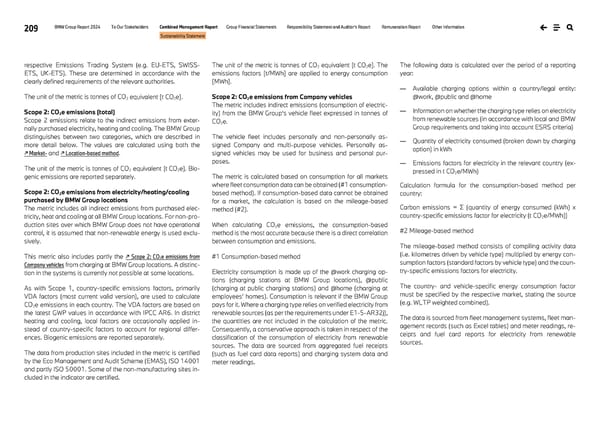209 BMW Group Report 2024 To Our Stakeholders Combined Management Report Group Financial Statements Responsibility Statement and Auditor’s Report Remuneration Report Other Information Sustainability Statement respective Emissions Trading System (e.g. EU-ETS, SWISS- ETS, UK-ETS). These are determined in accordance with the clearly defined requirements of the relevant authorities. The unit of the metric is tonnes of CO2 equivalent [t CO2e]. Scope 2: CO2e emissions (total) Scope 2 emissions relate to the indirect emissions from exter- nally purchased electricity, heating and cooling. The BMW Group distinguishes between two categories, which are described in more detail below. The values are calculated using both the ↗ Market- and ↗ Location-based method. The unit of the metric is tonnes of CO2 equivalent [t CO2e]. Bio- genic emissions are reported separately. Scope 2: CO2e emissions from electricity/heating/cooling purchased by BMW Group locations The metric includes all indirect emissions from purchased elec- tricity, heat and cooling at all BMW Group locations. For non-pro- duction sites over which BMW Group does not have operational control, it is assumed that non-renewable energy is used exclu- sively. This metric also includes partly the ↗ Scope 2: CO2e emissions from Company vehicles from charging at BMW Group locations. A distinc- tion in the systems is currently not possible at some locations. As with Scope 1, country-specific emissions factors, primarily VDA factors (most current valid version), are used to calculate CO2e emissions in each country. The VDA factors are based on the latest GWP values in accordance with IPCC AR6. In district heating and cooling, local factors are occasionally applied in- stead of country-specific factors to account for regional differ- ences. Biogenic emissions are reported separately. The data from production sites included in the metric is certified by the Eco Management and Audit Scheme (EMAS), ISO 14001 and partly ISO 50001. Some of the non-manufacturing sites in- cluded in the indicator are certified. The unit of the metric is tonnes of CO2 equivalent [t CO2e]. The emissions factors [t/MWh] are applied to energy consumption [MWh]. Scope 2: CO2e emissions from Company vehicles The metric includes indirect emissions (consumption of electric- ity) from the BMW Group’s vehicle fleet expressed in tonnes of CO2e. The vehicle fleet includes personally and non-personally as- signed Company and multi-purpose vehicles. Personally as- signed vehicles may be used for business and personal pur- poses. The metric is calculated based on consumption for all markets where fleet consumption data can be obtained (#1 consumption- based method). If consumption-based data cannot be obtained for a market, the calculation is based on the mileage-based method (#2). When calculating CO2e emissions, the consumption-based method is the most accurate because there is a direct correlation between consumption and emissions. #1 Consumption-based method Electricity consumption is made up of the @work charging op- tions (charging stations at BMW Group locations), @public (charging at public charging stations) and @home (charging at employees’ homes). Consumption is relevant if the BMW Group pays for it. Where a charging type relies on verified electricity from renewable sources (as per the requirements under E1-5-AR32j), the quantities are not included in the calculation of the metric. Consequently, a conservative approach is taken in respect of the classification of the consumption of electricity from renewable sources. The data are sourced from aggregated fuel receipts (such as fuel card data reports) and charging system data and meter readings. The following data is calculated over the period of a reporting year: — Available charging options within a country/legal entity: @work, @public and @home — Information on whether the charging type relies on electricity from renewable sources (in accordance with local and BMW Group requirements and taking into account ESRS criteria) — Quantity of electricity consumed (broken down by charging option) in kWh — Emissions factors for electricity in the relevant country (ex- pressed in t CO2e/MWh) Calculation formula for the consumption-based method per country: Carbon emissions = Σ (quantity of energy consumed (kWh) x country-specific emissions factor for electricity (t CO2e/MWh)) #2 Mileage-based method The mileage-based method consists of compiling activity data (i.e. kilometres driven by vehicle type) multiplied by energy con- sumption factors (standard factors by vehicle type) and the coun- try-specific emissions factors for electricity. The country- and vehicle-specific energy consumption factor must be specified by the respective market, stating the source (e.g. WLTP weighted combined). The data is sourced from fleet management systems, fleet man- agement records (such as Excel tables) and meter readings, re- ceipts and fuel card reports for electricity from renewable sources.
 BMW Group Report 2024 Page 208 Page 210
BMW Group Report 2024 Page 208 Page 210